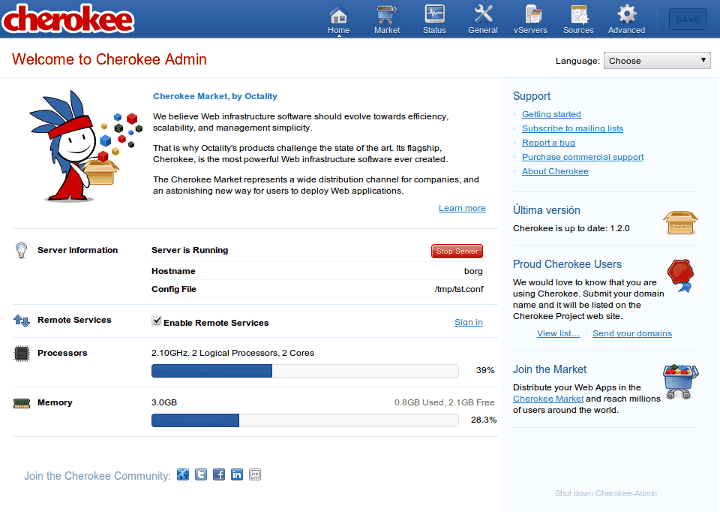
Cherokee Basics
Index → Getting started
Why Cherokee?
Welcome to the Cherokee 1.0 documentation. Cherokee is a high-performance web server. It is very fast, flexible and easy to configure. It offers support for the widespread technologies nowadays: FastCGI, SCGI, PHP, CGI, SSI, TLS and SSL encrypted connections, Virtual hosts, Authentication, on the fly encoding, Load Balancing, Apache compatible log files, Data Base Balancer, downtime-free updates and upgrades, Reverse HTTP Proxy, and much more.
It is highly efficient, extremely lightweight and provides rock solid stability. Among its many features there is one that deserves special credit: a user friendly interface called cherokee-admin that is provided for a no-hassle configuration of every single feature of the server. This administration interface allows you to configure the web server without having to worry about editing a text file written with a certain syntax.

Unlike many other web servers out there, Cherokee gracefully handles many concurrent connections, has a low memory footprint, and provides load balancing facilities. As such, it is suitable for usage among a wide variety of systems, from tiny embedded devices to huge enterprise grade infrastructures. It is also multi-platform, offering native performance for Unix, Linux and Windows systems.
By simply upgrading your existing web server to Cherokee, you can literally multiply your existing hardware’s performance, extending its life cycle or allowing you to have a smaller, more efficient, compact and easier to maintain IT infrastructure.
Best of all, Cherokee is free software, has a thoroughly designed architecture, is completely modular and has a clean and neat code base. Anyone and everyone can have access to the code for study and tinkering, thus allowing you to customize, modify, or extend everything to suit specific needs. It is also very actively maintained, and every interesting feature request is carefully considered.
As you can see, Cherokee comes with many goodies that allow to achieve unprecedented performance.
But don’t trust everything you are told. Check out the benchmarks and the rest of the documentation to learn more, and give it a try to squeeze your hardware to the fullest. You will not be disappointed. That you can trust.
